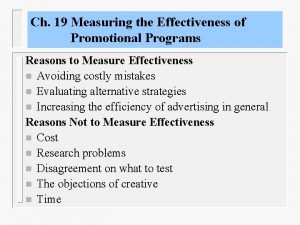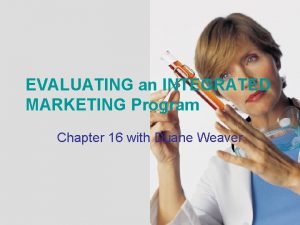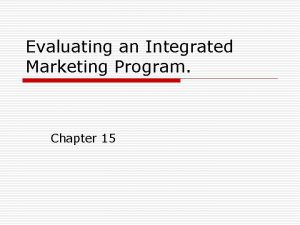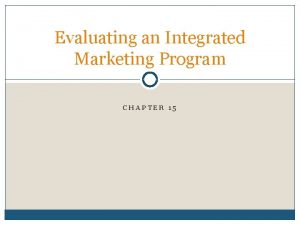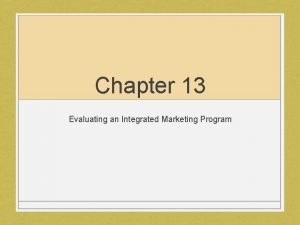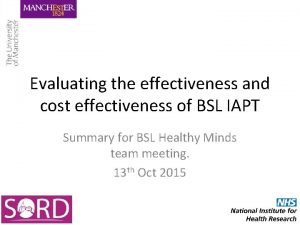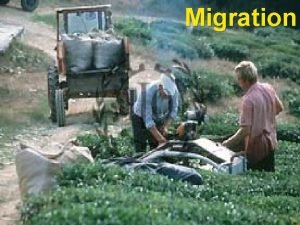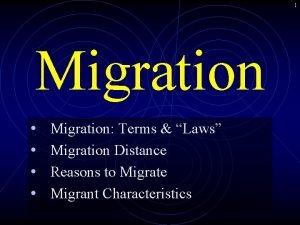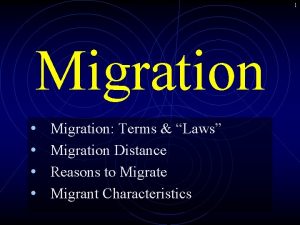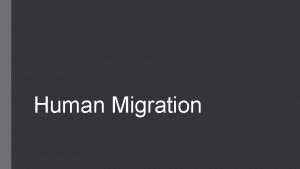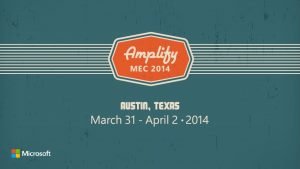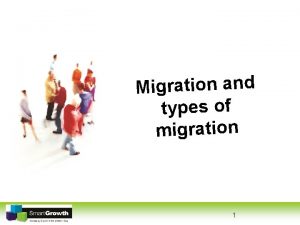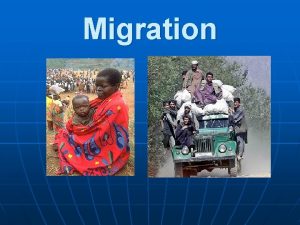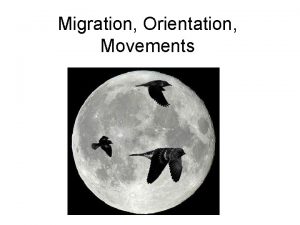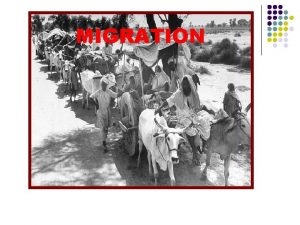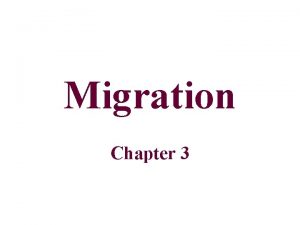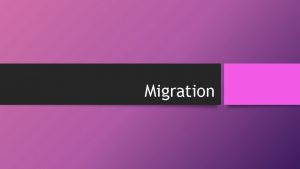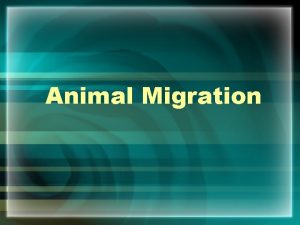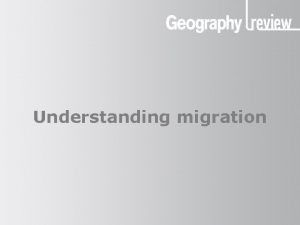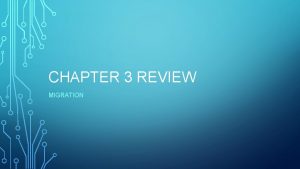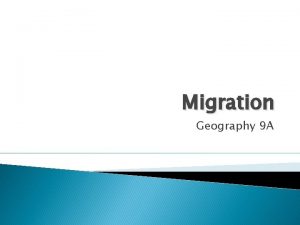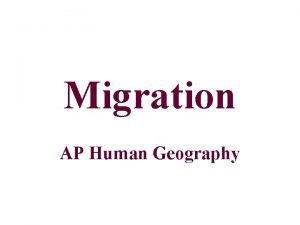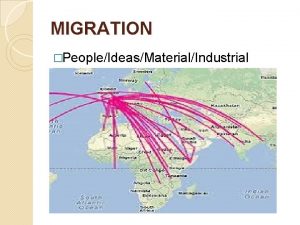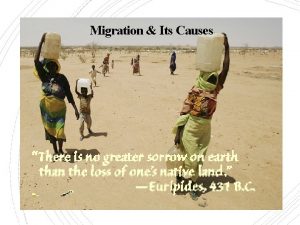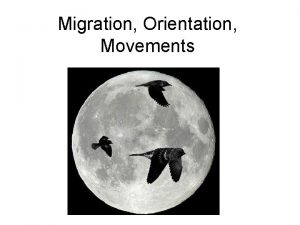Evaluating the Effectiveness of Regional Migration Program Models

























- Slides: 25

Evaluating the Effectiveness of Regional Migration Program Models on Providing Assistance to Vulnerable Migrants Final Presentation August 18, 2017

Purpose of the Evaluation • Identify program strengths and areas for improvement • Capture best practices, lessons learned, and actionable recommendations to inform the RMPs supported by Do. S/PRM and implemented by IOM. 2

Evaluation Questions To what extent are the Regional Migration Programs effective in building government capacity to humanely manage migration and address the needs of vulnerable migrants? To what extent do the focus areas of the Regional Migration Programs indirectly or directly contribute to strategic regional responses to irregular migration and vulnerable migrants? The focus areas (or pillars) include: To what extent is IOM responsive to feedback provided by beneficiaries including government partners and migrants? 1. Capacity Building 2. Direct assistance to vulnerable migrants 3. Links to regional migration dialogues 4. IOM-UNHCR coordination 5. Emergency migration management 3

Field Work in Six Countries Mesoamerica – Costa Rica – Mexico – Guatemala 4

Field Work in Six Countries Horn of Africa – Kenya – Ethiopia – Djibouti 5

Large and Comprehensive Sample Ho. A and Yemen (n=156) Mesoamerica (n=131) Female 27. 3% 46. 7% Male 72. 7% 43. 3% National/regional staff 33. 7% 78. 3% International staff 19. 2% 5. 8% Regional (incl. migrants) 47. 1% 15. 8% IOM staff 20. 9% 18. 3% National government 7. 6% 20. 5% Subnational or local government 14. 5% 20. 3% Other UN or NGO 7. 0% 28. 3% Beneficiary/migrant/returnee 47. 1% 5. 8% Other/donor/academic 2. 9% 5. 0% Type of respondent 6

The PRM-IOM Five-Pillar Model 1. Capacity Building 5. Emergency Migration Mgmt. 2. Direct Assistance Capacity Building 4. IOMUNHCR Coordination 3. Regional Dialogue 7

Breakdown of Program Spending Activity Ho. A Program (FY 2015 & 2016) % of Ho. A Budget Mesoamerica Program (FY 2015 & 2016) % of Mesoamerica Budget IOM Personnel 865, 800 29% 1, 872, 864 42% IOM Facilities 295, 030 10% 245, 458 5% Capacity Building 151, 000 5% 812, 317 18% Awareness Raising 205, 000 7% 375, 546 8% Direct Assistance and AVR 729, 000 25% 74, 900 2% MRC Support (Ho. A) 569, 200 19% 188, 855 4% Shelter Support (Mesoamerica) Regional Dialogue Emergency Migration Mgmt. Monitoring and Evaluation Total 98, 413 3% 762, 081 17% Not specified - 96, 300 2% 48, 400 2% 36, 680 1% 2, 961, 843 99% 4, 465, 001 100% 8

How is the IOM-PRM Model Working? • Inconsistent focus by IOM between regions • Strong emphasis in some cases on direct assistance unrelated to core capacity building objective • Challenges in maintaining focus solely or primarily on the most vulnerable migrants, as intended by PRM and IOM • The diversity of pillars may lead to a somewhat reduced level of emphasis on capacity building 9

Q 1: Capacity Building Beneficiaries in the Ho. A Program Location Q 1 Q 2 Q 3 Q 4 Total % of Total Hargeisa 49 0 0 20 69 12. 0% Bosasso 0 0 0 30 30 5. 2% Djibouti 0 0 0 44 44 7. 6% Yemen 0 16 0 84 100 17. 3% Ethiopia 0 105 64 165 334 57. 9% Total 49 121 64 343 577 - 8. 5% 21. 0% 11. 1% 59. 4% 100. 0% - % of Total 10

Q 1: Effectiveness of Capacity Building Knowledge • Substantial improvements according to IOM preand post-tests of training participants • Retention remains unclear Attitudes • Marked improvements, including in relation to women and child migrants Practices • Relatively limited gains outside of basics of psychosocial assistance in Mesoamerica • Interviewees indicate needs, especially on dealing with victims of trafficking and SGBV

Q 1: Additional Evaluation Issues • Strategy – Absence of any evidence base or strategy – In Mesoamerica, lots of effort but no theory of change • Reach – Limited attention to large-scale approaches such as intensive training-of-trainers or working with national gov’t institutions • Sustainability – IOM-led trainings and capacity building stretch IOM staff and create problems for sustainability if DOS funding slows/stops 12

Q 1 a: Responsiveness to Feedback • IOM is particularly responsive to feedback from governments and regional entities and, to a lesser extent, from migrants • Systematic approaches to documenting feedback and IOM responses are needed Officials in Guatemala with ET members 13

Q 2: Contribution to a Strategic Regional Response • Need to ensure that these “regional” programs take a strategic, regional approach • Project and country-based nature of IOM programming creates challenges, but some good practices have emerged Information Hub , Paso Canoas, Costa Rica 14

Q 2 b: Direct Assistance • What Is Working? – Great responses to ad hoc migration crises with direct assistance – Solid range of services for targeted migrants in Mesoamerica • What Merits Improvement? – Limited-to-no links between direct assistance and capacity building – Challenges in identifying and targeting most vulnerable migrants – Fixed infrastructure-based solutions seem to merit reconsideration 15

Q 2 b: Use of Migrant Infrastructure (Mesoamerica) Migrants Assisted October 2016 -March 2017 Average number of migrants assisted per month La Union, El Salvador 28 4. 7 Baru, Panama 30 5. 0 San Pedro Sula, Honduras 34 5. 7 San Marcos, Guatemala 84 14. 0 Palenque, Mexico 89 14. 8 Motozintla, Mexico 102 17. 0 Suchiate, Mexico 112 18. 7 Paso Canoas, Costa Rica 337 56. 2 Total 816 17. 0 Information Hub/Window 16

Q 2 b: Use of Migrant Infrastructure (Horn of Africa) Migrants provided with medical referral and assistance by MRC and IOM Non-food item distribution to migrants Assisted voluntary return completed by MRC and IOM Location 2013 -14 2014 -15 2015 -16 Hargeisa 1, 643 2, 277 1, 916 2, 425 54 64 96 54 240 Bosasso 34 21 113 3, 157 0 0 65 18 0 Djibouti 1, 666 482 0 713 0 1, 603 545 989 1, 065 Yemen 527 15, 446 7, 468 1, 891 4, 798 2, 782 165 1, 009 1, 978 Ethiopia 19 0 0 0 1, 569 1, 545 23 0 1, 834 Total 3, 889 18, 226 9, 497 8, 186 6, 421 5, 994 894 2, 070 5, 117 17

Q 2 b: IOM Staff Perceptions of Direct Assistance Horn of Africa: Forms of Assistance Percent Rating Effective or Very Effective Mesoamerica: Forms of Assistance Percent Rating Effective or Very Effective MRC support 100. 0% Information windows to provide information to the migrants 73. 2% Assisted voluntary return 84. 6% Direct assistance and voluntary return 73. 8% Unaccompanied children assistance and family reunification 76. 9% Communications campaigns 72. 1% Referral to partners 69. 2% Community-level prevention activities 73. 8% Psychosocial assistance 38. 5% UAC Response Units 47. 4% 18

Q 2 c: Regional Migration Dialogues • Strong Program Component – Technical discussions are frank and productive – Led directly to a greater emphasis on migrant children in Mesoamerica – IOM provided extensive technical support and added value • Opportunities for Improvement Remain – How to combine high-level and local-level dialogue, including by expanding the use of cross-border forums as in Mesoamerica – How to ensure follow-through by government officials 19

Q 2 d: IOM-UNHCR Coordination • Coordination – Absence of competition among agencies – Well-functioning referrals systems between IOM and UNHCR • Cooperation – UN agencies include one another in relevant activities – Joint proposals are being considered – but no follow through – Need for mutual cooperation on migration and protection 20

Q 2 e: Emergency Migration Management • New, promising pillar – if re-focused somewhat – Added by Do. S/PRM in FY 2016 -17; at initial stages of implementation within both regions examined – Some doubts about the pillar remain within IOM and within partner governments in the regions – in part based on the nomenclature (e. g. , Migrants in Countries in Crisis) – Should avoid trainings on MICIC and instead focus on contingency planning and drills/preparedness 21

What’s The Bottom Line? • Complex arrays of activities across multiple countries in each region with relatively limited resources • Programs are not rooted in evidence and generally lack underlying analysis or clear strategy • IOM ultimately has relatively limited coherence or lasting impact despite doing strong work in particular areas 22

Overarching, Strategic Recommendations 1. IOM should simplify its activities, focusing only on those deemed likely to build lasting government capacity 2. IOM should introduce systematic approaches to M&E of capacity building activities 3. IOM should articulate a capacity building strategy reflecting a medium-to-long-term vision with graduated steps 4. IOM should design and implement a handover strategy 5. IOM should broaden partnerships for capacity building, M&E, research, and more 23

Questions?

socialimpact. com 2300 Clarendon Blvd. #1000, Arlington, VA 22201 703. 465. 1884
 Measuring the effectiveness of promotional program
Measuring the effectiveness of promotional program Evaluating an integrated marketing program
Evaluating an integrated marketing program Evaluating an integrated marketing program
Evaluating an integrated marketing program Evaluating an integrated marketing program
Evaluating an integrated marketing program Evaluating an integrated marketing program
Evaluating an integrated marketing program Shall will difference
Shall will difference Hát kết hợp bộ gõ cơ thể
Hát kết hợp bộ gõ cơ thể Frameset trong html5
Frameset trong html5 Bổ thể
Bổ thể Tỉ lệ cơ thể trẻ em
Tỉ lệ cơ thể trẻ em Voi kéo gỗ như thế nào
Voi kéo gỗ như thế nào Chụp tư thế worms-breton
Chụp tư thế worms-breton Hát lên người ơi
Hát lên người ơi Các môn thể thao bắt đầu bằng tiếng nhảy
Các môn thể thao bắt đầu bằng tiếng nhảy Thế nào là hệ số cao nhất
Thế nào là hệ số cao nhất Các châu lục và đại dương trên thế giới
Các châu lục và đại dương trên thế giới Công thức tính độ biến thiên đông lượng
Công thức tính độ biến thiên đông lượng Trời xanh đây là của chúng ta thể thơ
Trời xanh đây là của chúng ta thể thơ Cách giải mật thư tọa độ
Cách giải mật thư tọa độ 101012 bằng
101012 bằng độ dài liên kết
độ dài liên kết Các châu lục và đại dương trên thế giới
Các châu lục và đại dương trên thế giới Thơ thất ngôn tứ tuyệt đường luật
Thơ thất ngôn tứ tuyệt đường luật Quá trình desamine hóa có thể tạo ra
Quá trình desamine hóa có thể tạo ra Một số thể thơ truyền thống
Một số thể thơ truyền thống Cái miệng nó xinh thế chỉ nói điều hay thôi
Cái miệng nó xinh thế chỉ nói điều hay thôi
